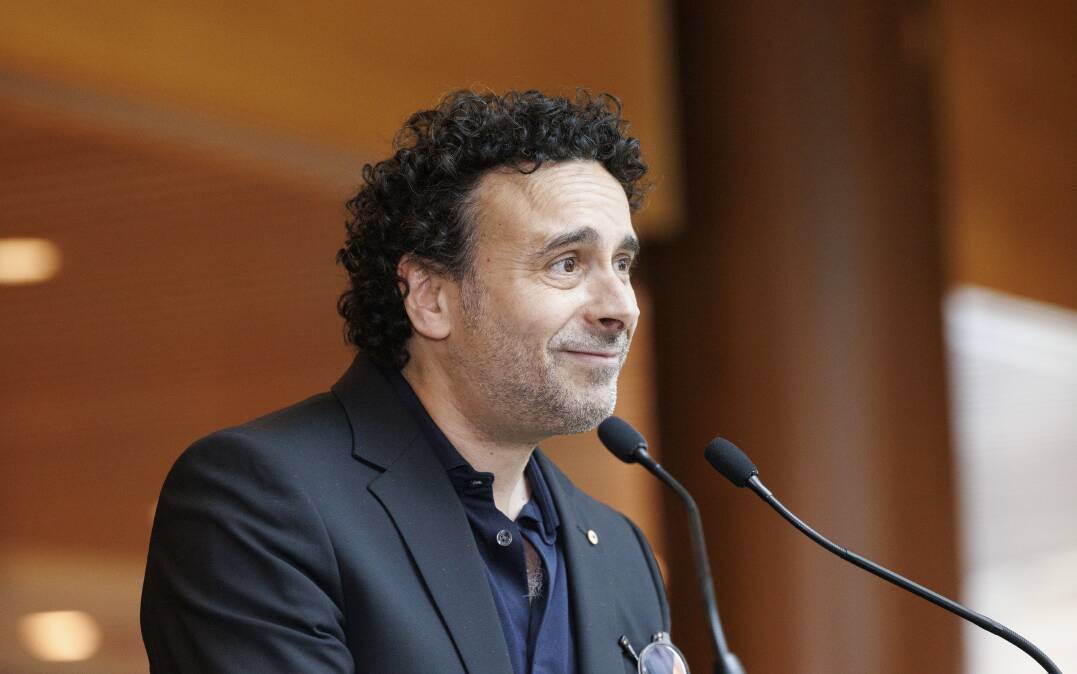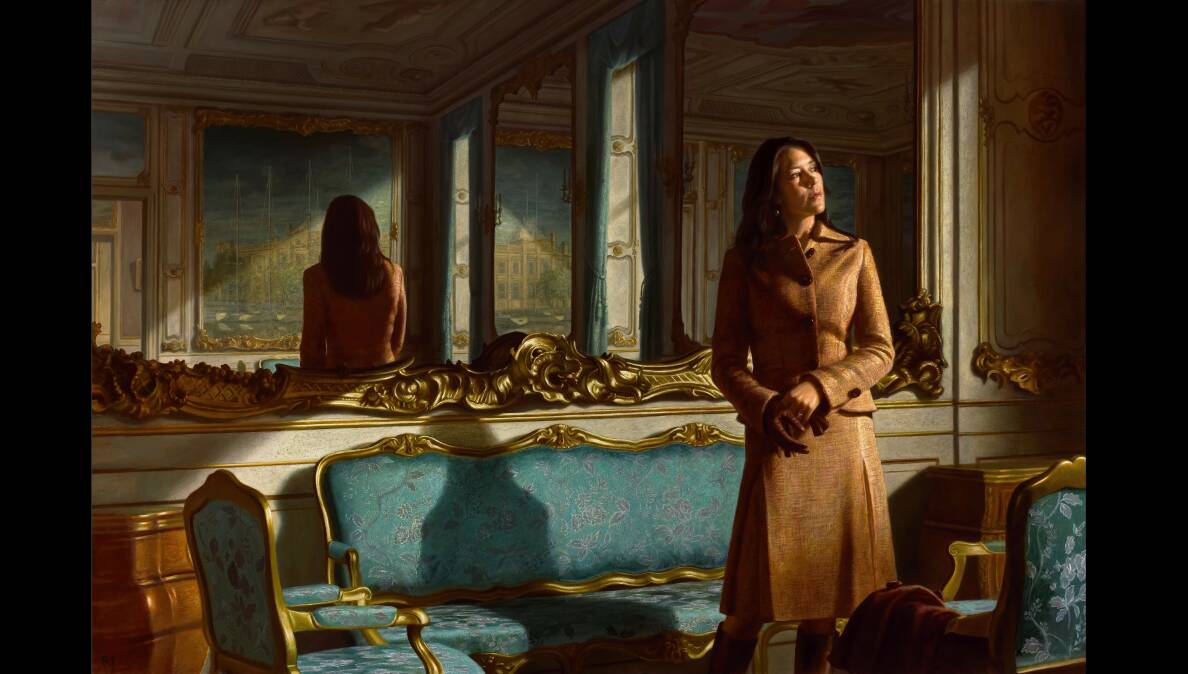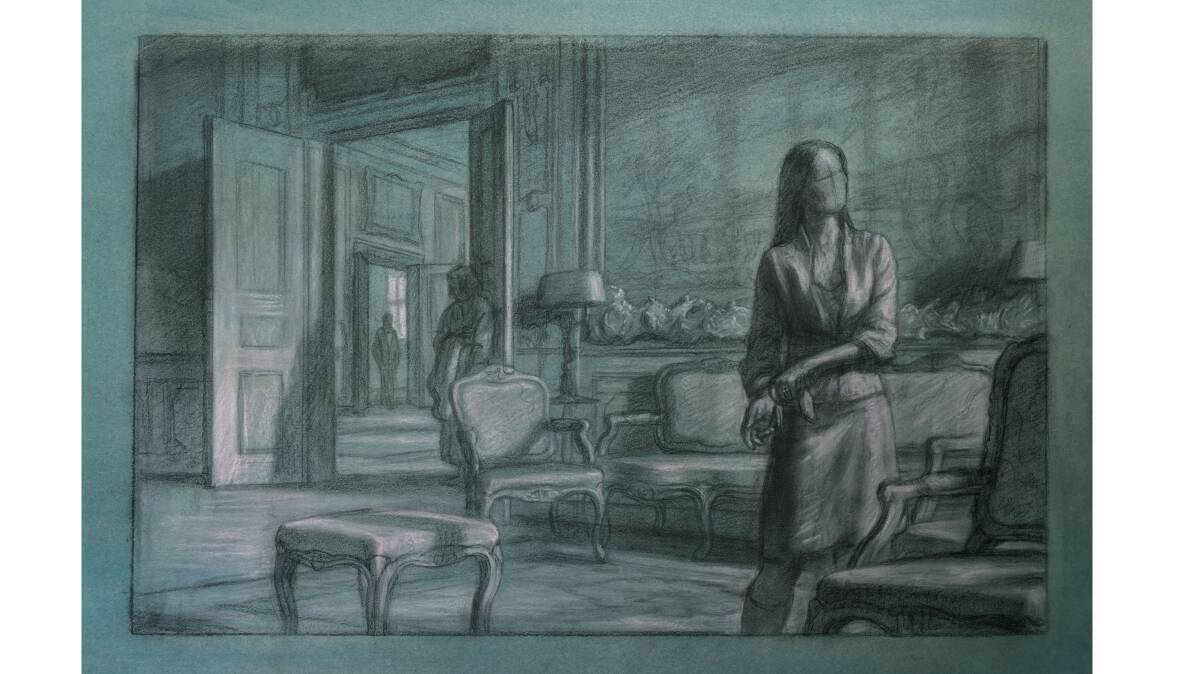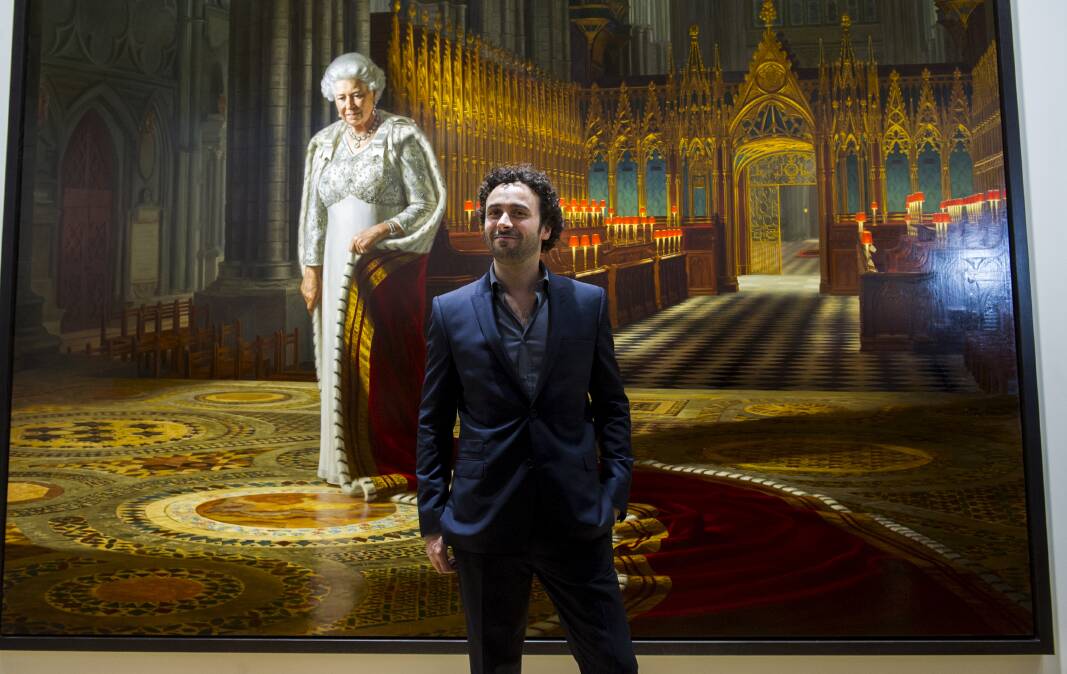It makes sense that artist Ralph Heimans studied pure mathematics, as well as fine art.
His stunning portraits - of everyone from Queen Elizabeth II to actress Judi Dench to then Crown Princess Mary - are meticulously planned and executed.
The proportions, the composition, the angles, the perspective are just so.
"You need that left brain element as well," he said, of creating his uber-realistic yet still otherworldly portraits.
That's quite apart from his attention to detail which teases out the story and the humanity of the subject, usually after months of research.

"The human dimension is the most important dimension," Heimans said.
"If you don't feel or empathise with the subject, if you're not transported emotionally in some way by the painting, then it hasn't succeeded. It's not enough to be engaged intellectually."
The exhibition at the National Portrait Gallery may be called Ralph Heimans: Portraiture. Power. Influence but the artist is focused on discovering the person behind the position, whether that be now King Charles III or Australia's 26th prime minister Kevin Rudd or writer Margaret Atwood.

"I'm extremely excited," he said, from his studio in Sydney.
"It is the first major exhibition I've had in Australia, apart from having some works permanently in the collection of the National Portrait Gallery.
"The gallery been a huge support throughout my career. So many of the breakthroughs I've had have actually originated from the gallery. So I owe a lot to the gallery, and it's very fitting that the first show I have in the country is there."
The exhibition has been four years in the making, interrupted by COVID and a change of directorship at the gallery.

But now it is here - opening at the National Portrait Gallery on Friday March 15 and continuing until May 27.
The Australian show was first talked about when Heimans had a major retrospective at the National Portrait Gallery of Denmark in 2018, after painting a portrait of then Crown Princess Mary in 2006 and then being commissioned to paint then Crown Prince Frederik for his 50th birthday.
"The original discussions were that that exhibition would travel to Australia but then it was decided Australia would develop its own show and that is what has happened and finally come to fruition," he said.
The exhibition in Canberra will feature examples of his royal portraits including those of then Crown Princess Mary and Crown Prince Frederik and then Prince Charles.
There will also be portraits of public figures including then Governor-General Quinten Bryce and Justice Michael Kirby.
And also examples of his work from private commissions, sourced from collections around the world.
The exhibition also includes studies of his famous painting of Queen Elizabeth II in 2012 for her Diamond Jubilee and of Prince Philip, the Duke of Edinburgh, painted in 2017.
The portrait of the Queen is now part of the Westminster Abbey Collection and the one of Prince Philip is in the Royal Collection, the Queen so taken by the depiction of her husband that she made sure to acquire it.
"Those portraits are very large. The one of the Queen is permanently installed in the Abbey as part of the fabric of the Abbey and is 2.5 by 3.5 metres. It's a massive work and doesn't move, effectively," Heimans said.
But Heimans' Diamond Jubilee portrait of the Queen was on display at the National Portrait Gallery for six months over 2012-2013, attracting 100,000 people, leading the gallery to say it was its most popular painting ever.
It's remarkable that three of Heimans' subjects have now become monarchs themselves since he painted them - the now Queen Mary and King Frederik of Denmark through the abdication of former Queen Margrethe, and King Charles III through the death of his mother in 2022.
Not that they rang him to tell them of their change in circumstance.
"There have been follow-ups with most of the royals at various occasions, but we're not on speed dial," Heimans said with a laugh.
Heimans, 54, grew up in a "middle-class, stable, sheltered, suburban" environment in Cremorne on the lower north shore of Sydney.

His father was a documentary maker, his mother a French teacher. His younger brother, Jeremy Heimans, was a co-founder of the activist organisation GetUp!.
Heimans started painting with oils when he was just 14.
"I think going to Mosman High, which had the best art department possible for me, that was really helpful in defining my vocation. Because while I was at school, I won the National Art Prize and with the prize money I was able to travel and work out my path. I was quite a headstrong young man determined to be an artist but I wanted to find my own path."
The prize money allowed him to head straight to Europe "where I felt very much at home. Close to the old masters. They were my source of inspiration". He now divides his time between London and Sydney.
"London has been for the past 30 years my main work base. In the 1990s I moved to Paris from Sydney and all my work was based in London and I moved there in earnest in 2007," he said.
His wife Tami and their daughters Ellie-Rose and Hannah will be at the exhibition opening at the National Portrait Gallery in Canberra on March 15.
Justice Michael Kirby, a former subject and long-time supporter of Heimans, and the portrait gallery were instrumental in securing him the honour of the Golden Jubilee portrait of the Queen. And, before that, the gallery put his name forward to paint Crown Princess Mary. Heimans says the portrait gallery has been central to his work.
"The early Australian years really did set up my entire career," he said.
Heimans is now working on a portrait of English anthropologist Dr Jane Goodall.
"The portrait is destined to go to the Natural History Museum in London which is very exciting," he said.
"They'll be a sort of Australian component to that as well, because there's a chapter of the Jane Goodall Institute in Australia."
And there will be chimpanzees in the portrait.
"I've already had a sitting with Jane at her home in Bournemouth in the UK but she's going to be in Africa and I'm going to join her there in July. I'm going to find the chimps," Heimans said, with a laugh.
Ralph Heimans on painting...
Princess Mary of Denmark, 2006

Ralph Heimans painted now Queen Mary of Denmark in 2006. He had his first meeting in Denmark with then Crown Princess Mary in 2005, when she was fresh into her royal role, just a year after the Tasmanian-born former real estate agent had married then Crown Prince Frederik.
"It was an extremely exciting commission. It was my first royal portrait [and I stayed] as artist-in-residence in the royal palace, one of the royal residences which was Frederiksborg Castle. It was a very easy encounter with her. The cultural familiarity really did help.

"But I was able see her in this particular period, very early on in her role. She'd only been princess for a year at the time and she was actually pregnant with her firstborn. It was within the first three months, so it hadn't been announced. So it was a very exciting time. She was adapting to her role and there was a lot of buzz around her. And she was emerging as this fashion icon. She was learning Danish.
"I really caught her at this sort of early stage and it was very interesting to see how she was adapting to the role, the seriousness and dedication - I could just see. She would occasionally break out into Danish when she was talking to me. Her head was so into taking on this new role. I saw [her] as somebody who was adopting this very professional stance to becoming a princess. It was a moment of vulnerability, trying to find her footing in this new role and, of course, there was public scrutiny of her. So I tried to express some of those ideas in the painting."
Dame Judi Dench, 2018

"Just such a wonderful, down-to-earth person. Very warm.
"We met in the Royal Haymarket Theatre, which she had chosen as the venue for her portrait because she has some of her best early memories of life in the theatre there.
"The painting was very much based on that idea of her thinking back to her early times in the theatre, so she's turning over her shoulder and looking back, at the spot in centre-stage in between the wings at front of stage which is quite an exciting place to be in an empty theatre."
Margaret Atwood, 2016

"She is a very formidable writer and a very strong personality. It was a very exciting project to be involve in because it was a collaboration with Random House which was producing this series of books and they had invited authors to choose a play from Shakespeare and re-tell it.
"So Margaret Atwood chose The Tempest and I, of course, identified her with the figure of Prospero, who many people say is a reflection of the playwright Shakespeare himself.
"So she very much fitted into the role as the great matriarch of modern literature. We met in London at the Royal Over-Seas League for a sitting and she's, obviously, a very profoundly intelligent, engaging person, so it was a very intense sitting.
"And she was very playful with going along with a number of ideas and turning herself into Prospero. She was a very willing participant. And it was a very lively exchange. It was great."
Justice Michael Kirby, 1998

"Kirby has been just such a great supporter and friend over the years.
Meeting him, he never made me feel intimidated or uncomfortable. In retrospect, now that I look back, I was this 26-year-old, or even possibly 25-year-old, when I was meeting him for the first time and he was in the middle of one of the most important cases that he's ever had in his career, the Wik decision. So I caught him right at the tail-end of that and he gave me his time at this extraordinary moment. He saw promise in the work that I'd done and also, I produced a sketch for my ideas for a portrait of him and it was a wonderful experience.
"It was the beginning of a very strong friendship. We're still really close. And he's such a generous man, fascinating, always plotting new ideas and new portraits in this wonderful collaborative way. I feel just so privileged to have had that friendship in my life."
Her Majesty Queen Elizabeth II, 2012

"It really was quite an experience meeting her. It's hard to explain. She has a particular presence. What did strike me, actually, was just the physicality. She's smaller than you think and she really does have these soulful eyes and this wise demeanour.
"So, it's slightly disarming. Of course, you make these figures larger than life in your mind but when you meet her, you're really confronted with the person. She does have this strength that I was trying to capture.
"It was a remarkable meeting. Obviously, it meant everything to my career. It was a make it or break it painting. A once-in-a-lifetime opportunity to do this portrait.
"I was obviously terribly nervous and had big ambitions. I wanted to achieve this sort of rather large, expressive piece where she would look reflective, which was quite against type at the time. At that time, she was depicted with this broad smile on the front page of all the papers. It was the Summer Olympics in London and it was this positive, happy time.
"I chose to depict her looking downwards, in this reflective pose. I knew I was going to do something against the mood at the time but I thought that was something relevant to the gravity of the Diamond Jubilee, having spent 60 years on the throne, and {I wanted to] show something internal and personal about her."
The Prince of Wales, 2018

The portrait was unveiled by HRH the Prince of Wales in November 2018 at an event to honour his 70th birthday at Australia House, London.
"It was amazing. We have a lot in common. He loves art, loves painting, he actually paints himself. A lot of his causes - the environment, the preservation of historical architecture - resonate with me personally. So we had a lot of to chat about. He's very lively. He's very passionate about the causes he believes in.
"And it was really good to see that first hand - this genuine conviction he had. When we talked about the environment, he would almost stand up.
"And in the painting itself, I wanted to express that he wasn't someone waiting around to be king. On the contrary, which is definitely the man I observed, he was in the midst of the work and his causes. This was his life mission and every day was sort of a seize-the-day moment where he wanted to make the most of advancing these causes. And I found that really admirable to see someone being so passionate.
"When you do a portrait, you spend a lot of time with the staff around the person - the equerries and the footmen - and you learn a lot from their attitudes towards them. He was always described as this workaholic with a very strong worth ethic.
"He would take himself out on these walks where he would do most of his work and his thinking. That's why in the painting, I have him looking out the window at Dumfries House to a tree outside. The oak tree is a symbol of the monarchy, but also his connection to nature. He's got this walking staff in hand, which is very characteristic. He's got them in big baskets beside every door, ready to head out at any time on one of these walks."
Kevin Rudd, 2023

The portrait of the 26th prime minister of Australia, now Australia's ambassador to the United States, was unveiled at Parliament House in Canberra last year.
"It was a real pleasure meeting Kevin. We had a really great connection.
"Before the pandemic, we met to discuss the painting and then, of course, everything was interrupted but we continued for a while over Zoom, developing ideas.
"When, finally, I was able to get to Australia after the pandemic, I spent a week with him in his home on the Sunshine Coast. So we had put a lot of thought and effort into it and there was definitely a desire to represent him as he is now, rather than back then because it had been 10 years since he'd been prime minister at the time of the painting.
"It was important to focus on his life since. He was the head of the Asia Society in Australia and this spokesman on China but his new role as ambassador to the US was not in play during the painting.
"The moment that Louis [the cat] walked across the chessboard during the sitting, I knew that had to be in the painting. It was just classic.
"The elements that surround him are very much part of his life. There's reference to the Apology [to the Stolen Generations] in the work and the Chinese vases and Aboriginal art. That is his world and that is what is in his home. It says so much about him."
Quentin Bryce, 2014

"It was a really incredible experience. She's a remarkable woman.
"This was an important portrait as it was to reflect her legacy. It was to be unveiled when she retired from her position as governor-general and coincided with her being made a Dame, which was very exciting.
"We worked together to reflect her time in the position. I had her standing outside her office at Government House in Yarralumla. The glass reflected the nature outside, which also referenced her commitment to rural Australia, and also represented breaking through the glass ceiling while she was wearing suffragette purple.
"Writing personal letters had also been one of the hallmarks of her time as governor-general and that is represented in the portrait as well."
- RALPH HEIMANS: Portraiture. Power. Influence is on at the National Portrait Gallery from March 15 to May 27.







